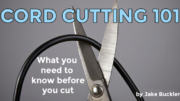In life, nothing lasts forever. This is especially true of TV antennas. Antennas are built to be light and and strong. They are generally made of aluminum because it’s the best combination of weight, strength, cost, and conductivity.
This tutorial will give you a lot more information, but here’s the gist of it. You want an antenna to be light because a heavy antenna is hard to ship and harder to mount. You want it to be strong so it withstands the weather. It has to be cheap enough that people can buy it, and it has to actually be good at picking up signal.
Aluminum is pretty good but…
It’s impossible to have everything. Aluminum is light and strong, but a hollow aluminum post is not as strong as a solid steel rod. Eventually, over time, those aluminum elements are going to bend. Something is going to hit it or hang on it, or something. It could be nothing more than a really tenacious icicle. That would be bad luck, but it does happen.
So a bent element happens. Then what?
The first question is, does the antenna work any worse for you? Sometimes that bent element corresponds to a channel you don’t get. Sometimes it still works well enough that it isn’t a problem.
But what about a case where that bent element really does affect the antenna’s performance? Should you try to bend it back?
In most cases, no.
A bent antenna is never going to be as good as a brand new one, but there are a few exceptions. If the antenna is really, really old, it may have just been hinges that wore out, not the antenna elements themselves. In that case you may be able to shim or repair the hinges to restore an older antenna to good-as-new status. Antennas made 50 years ago tend to be more durable because people paid a lot more money for them than they would now.
For the most part you are much better off getting a new antenna. There’s no point to repairing an old antenna when today’s antennas are designed for today’s needs. If you’ve got an old yagi-style antenna then at least a quarter of its elements aren’t used anymore. Newer antennas are better engineered for today’s TV broadcasting.
Where to get the antenna you need
If you are thinking of getting a new antenna, I hope you’ll consider shopping at Solid Signal, as they do keep the lights on here. You’ll find the best selection of antennas on the internet, from small ones that work inside to big ones that can pick up signals when nothing else can. If you’re looking to replace that big yagi-style antenna with another big yagi-style antenna, you’ll find what you need. You may also be surprised to find that today’s antennas are much smaller and even more durable.
The advent of low-noise amplifiers for antennas has made it possible to have small antennas that can perform as well as older, bigger ones. These smaller antennas are more attractive and are often encased in plastic which makes them more durable too. Why not give your antenna system an upgrade? Better looks, better performance, and more durability? Sounds like a perfect scenario.
One more word…
These days we all talk about sustainability and how important it is not to put too much into a landfill. Aluminum is one of the most commonly recycled metals and your aluminum antenna contains a lot of highly recyclable metal. When you do decide to upgrade, be sure to help the planet out and take your old antenna to a recycling center that can help turn it into something else.





